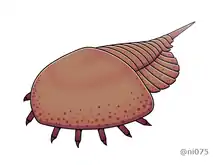Camanchia
Camanchia is a genus of synziphosurine,[1] a paraphyletic group of fossil chelicerate arthropods.[2][3] Camanchia was regarded as part of the clade Prosomapoda.[4][5][6][3] Fossils of the single and type species, C. grovensis, have been discovered in deposits of the Silurian period in Iowa, in the United States.[7][2] Alongside Venustulus, Camanchia is one of the only Silurian synziphosurine with fossil showing evidence of appendages.[1]
| Camanchia | |
|---|---|
 | |
| Reconstruction of Camanchia grovensis | |
| Scientific classification | |
| Kingdom: | Animalia |
| Phylum: | Arthropoda |
| Subphylum: | Chelicerata |
| Clade: | Euchelicerata |
| Clade: | Prosomapoda |
| Genus: | †Camanchia Moore et al., 2011 |
| Type species | |
| †Camanchia grovensis Moore et al., 2011 | |
The prosoma of Camanchia covered by a smoothly curved subtriangular carapace with broad doublure (ventral thickening run through the margin of carapace).[1] Detail of the 6 prosomal appendage pairs (chelicerae+5 leg pairs) obscure, at least the first leg pair (appendage II) have spur-like terminations.[1] Opisthosoma is externally 10-segmented with tergites possses blunt pleurae (lateral extension).[1] The last 3 opisthosomal segments forming a narrow postabdomen with short pleurae.[1] Telson is yet to be discovered.[1] The carapace margin and pleurae possess tubercles.[1]
References
- Moore, Rachel A.; Briggs, Derek E. G.; Braddy, Simon J.; Shultz, Jeffrey W. (2011). "Synziphosurines (Xiphosura: Chelicerata) from the Silurian of Iowa". Journal of Paleontology. 85 (1): 83–91. doi:10.1666/10-057.1. ISSN 0022-3360. S2CID 115132351.
- Lamsdell, James C. (2013). "Revised systematics of Palaeozoic 'horseshoe crabs' and the myth of monophyletic Xiphosura". Zoological Journal of the Linnean Society. 167 (1): 1–27. doi:10.1111/j.1096-3642.2012.00874.x. ISSN 0024-4082.
- Bicknell, Russell D. C.; Pates, Stephen (2020). "Pictorial Atlas of Fossil and Extant Horseshoe Crabs, With Focus on Xiphosurida". Frontiers in Earth Science. 8: 98. Bibcode:2020FrEaS...8...98B. doi:10.3389/feart.2020.00098. ISSN 2296-6463.
- Selden, Paul A.; Lamsdell, James C.; Qi, Liu. "An unusual euchelicerate linking horseshoe crabs and eurypterids, from the Lower Devonian (Lochkovian) of Yunnan, China". Zoologica Scripta. 44 (6): n/a. ISSN 0300-3256.
- Lamsdell, James C.; Briggs, Derek E. G.; Liu, Huaibao P.; Witzke, Brian J.; McKay, Robert M. (2015). "A new Ordovician arthropod from the Winneshiek Lagerstätte of Iowa (USA) reveals the ground plan of eurypterids and chasmataspidids". The Science of Nature. 102 (9–10): 63. Bibcode:2015SciNa.102...63L. doi:10.1007/s00114-015-1312-5. ISSN 0028-1042. PMID 26391849. S2CID 8153035.
- Bicknell, Russell D. C.; Lustri, Lorenzo; Brougham, Tom (2019-12-01). "Revision of "Bellinurus" carteri (Chelicerata: Xiphosura) from the Late Devonian of Pennsylvania, USA". Comptes Rendus Palevol. 18 (8): 967–976. doi:10.1016/j.crpv.2019.08.002. ISSN 1631-0683.
- Dunlop, J. A.; Penney, D.; Jekel, D. (2020). "A summary list of fossil spiders and their relatives" (PDF). World Spider Catalog. Natural History Museum Bern. pp. 1–296.